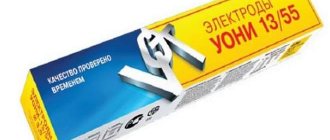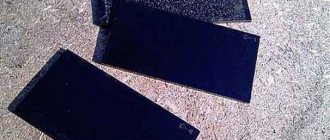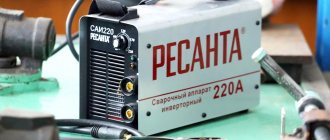In production, the chief engineer is responsible for ensuring safety. He must ensure that the workplace is safe, and the worker is protected by a special suit, goggles or welding helmet, and he must also have gloves, which are called welding gauntlets.
In everyday life, protective equipment is often neglected. However, only compliance with safety precautions guarantees the safety of the employee’s health, so they cannot be neglected.
Types of welding goggles
So, as already noted, welding work requires strict adherence to safety precautions. To do this, it is necessary to use a welding suit that protects the employee from exposure to high temperatures, as well as welding glasses to protect the eyes.
Welding work must be performed in accordance with all safety requirements.
Among other things, it is necessary to reliably protect the worker’s hands, which are in close proximity to the equipment and the sparks emanating from it. For this purpose, special welding gloves are used - split welding gauntlets.
The main purpose of special gloves is to protect the hands and forearms from splashes of hot material generated during work. They also protect the skin from burns that can be caused by accidental contact with the hot surface of the workpiece.
Such protection is used not only in the noted field of activity.
Gaiters are part of the equipment of representatives of such professions as:
- welders;
- blacksmiths;
- metallurgists;
- specialists in other fields working at high temperatures.
Protective gloves are made from a special material – split leather. This is genuine leather obtained by the lamination method. The main characteristic of this material is its high resistance to high temperatures, cuts and punctures.
The plasticity of split leather does not limit or impede movement. Without special impregnation, such mittens can be used at temperatures up to 50 °. Treatment with fire retardant impregnation increases the temperature limit to 100 degrees.
Protective gloves come in different modifications.
Two-fingered welding gaiters.
According to their design features they are divided into:
- five-fingered;
- two-toed;
- three-toed;
- insulated;
- combined.
The first option is the most universal. Such gauntlets are used when performing various welding and installation works. They do not restrict finger movements and are characterized by high operating comfort.
Two-fingered ones are used in electrode welding. They reliably protect against high temperatures and reduce stress on your hands.
Three-fingered leggings are an analogue of the previous type of protection. The features of insulated mittens are clear from their name. An additional layer of fur, fleece or high-density cotton fabric is used here.
In addition to split leather, tarpaulin and felt materials can be used as a material for gloves. However, it is the first one that is among the most popular and reliable.
Popular manufacturers
There are quite a large number of manufacturers on the market for the production of welding gloves. Most of the companies are located in Russia. Some major industry representatives will be listed below.
Technoavia is a large manufacturer of special and corporate clothing and uniforms, safety footwear, and personal protective equipment. The company sells its own products and goods from large factories of the relevant profile.
Vostok-Service is a manufacturer and supplier of a wide range of special clothing, footwear and personal protective equipment.
Sirius Group of Companies is one of the five best Russian manufacturers of workwear, work shoes, uniforms and personal protective equipment.
“Factory Trud” is an enterprise with a rich history, one of the oldest manufacturers of metal, fabric and leather products.
Avangard-Spetsodezhda produces and sells a wide range of quality products for specialists in various professions.
Dneprkozhgalantereya company is the undisputed leader in the market for the production of personal protective equipment for hands. the DOLONI trademark
More detailed information is presented in the article “Welder's Leggings”.
Welding guard design options
You can choose welding gloves not only by the material from which they are made, but also based on their design.
It can be:
- mitten or glove with a short cuff;
- extended welding guards that protect the forearms;
- five-fingered gloves.
An important element of the “design” of any welding gloves is the wide bell. It is necessary so that in the event of a fire or other unforeseen situations, the worker can easily and quickly remove them from his hands.
Depending on the thread used to stitch the gloves, their design also changes. The use of Kevlar thread does not impose additional requirements for the manufacture of mittens. This material of the para-aramid group is characterized by high strength and fire resistance.
In addition to Kevlar, Dacron thread can be used. This material cannot boast the same characteristics. The use of this material requires additional reinforcement of the seams with narrow leather inserts.
When choosing welding gloves, you need to focus on the conditions in which you will be working. This will determine the shape for the welder. In the cold season, you should give preference to insulated leggings and a winter suit.
An important feature of any welding suit is its high resistance to elevated temperatures. This will ensure work safety and protect the skin from thermal damage.
Requirements
Mittens should provide a high level of protection for the welder's hands. Therefore they must meet the following requirements :
- fire resistance – protection from sparks and hot splashes;
- strength - punctures, tears and cuts are unacceptable;
- durability;
- wear resistance;
- high-quality tailoring: uniform seams, no unstitched areas;
- presence of moisture-repellent properties;
- mittens intended for use in winter must have insulation.
Features of care
The need to protect your eyes when performing welding work is not just a common condition. Compliance with this requirement is absolutely necessary when working. Failure to use safety glasses poses a huge risk to human health.
The vast majority of injuries sustained in such production are caused by the presence of metal splashes, sparks, slag, and sawdust. If small particles get into your eyes, they can cause injury.
Welding glasses are the most reliable way to protect your vision and protect yourself from unwanted health consequences. It is simply impossible to overestimate the importance of glasses in production. However, this element of protection alone will not be enough.
The welder must use a welding shield with a dimming function depending on the brightness of the arc. This function automatically changes the transparency of the glass, ensuring comfortable visibility while working.
Using a mask will help prevent inflammation of the cornea from exposure to heat and light radiation from the arc. The importance of using an element such as split leather gaiter for welding has been described above.
A type of extended welding claws.
However, the use of these protective measures should not be considered a replacement for safety requirements. These elements only complement them.
In order for protective equipment to perform its direct functions for a long time and reliably, it is necessary to maintain it in working condition. As for glasses, visual inspection is sufficient for this protective equipment.
Inspect them before each use. The presence of any visible defects is a signal to replace the old glasses with new ones. Store them in a dust-proof case.
Caring for welding glasses is practically no different from caring for regular corrective glasses or sunglasses. Moreover, they are not that expensive, so it is better to change this safety element in a timely manner rather than risk your health.
Maintenance of the mask comes down to monitoring the filter glasses. If they have defects such as cracks, scratches, chips, etc., it is necessary to replace the glass. The mask itself must be wiped regularly. The use of detergents for cleaning is prohibited.
Use a soft, lint-free cloth for cleaning. Otherwise, the operation of the optical sensors may be disrupted.
Even the cost of simple welding gloves is not small, but advanced leather analogues will cost two to three times more. There is hardly a person who is ready to constantly buy new mittens for himself.
To avoid unexpected expenses, it is necessary to monitor and properly care for this equipment. It is enough to adhere to only a few requirements, and the gloves will last much longer.
First of all, mittens must be washed regularly. The easiest way to cope with this is with tarpaulin and felt products. Spilk is more picky. You will have to tinker with such material.
Leggings should be cleaned with products that are used to care for regular leather products.
Mittens must be dried thoroughly. If moisture remains inside, then the thermal conductivity of the gloves will increase and the worker may burn his hands.
In addition, do not forget that high-quality leather is prone to shrinkage. As a result, the size of the mittens may decrease after cleaning. Don't worry ahead of time. After complete drying, the product will return to its original appearance.
Don't forget to take care of your equipment. If you carry out proper and timely care, work clothes will retain their protective properties for a long time and will last for many years.
Prices for protective products for welding
The cost of welding equipment items varies for each component. The more a person is willing to pay, the higher quality of the form he will receive.
Kevlar thread for making leggings.
Classic welding shields are very similar to their counterparts that were used more than 40 years ago. Only instead of leather, pressed plastic is used. This item can provide basic eye protection.
The tinted glass can be lowered or raised depending on the presence of an arc. This is done either with the hands or with a sharp nod. To simplify this action, you can use modern shields with an automatic dimming function.
Instead of ordinary glass, an LCD display is installed here, changing its transparency depending on the presence of an arc and its brightness. This mask costs significantly more than the classic version. However, its practicality more than pays off.
Eye protection glasses are inexpensive. This piece of equipment can be easily replaced with another if necessary.
Leggings made of leather, canvas or cotton fabric for welding can vary greatly in price depending on the material and style. The most expensive are split mittens. This material is the most convenient for work and has the highest characteristics.
For tasks that do not require interaction with high temperatures, canvas gloves can also be used. They are easy to maintain and cost the least.
When working at low temperatures, you should purchase winter welding overalls and insulated leggings.
How to choose welding equipment?
Gaiters to protect the welder's hands.
The choice of equipment is determined by the conditions of its use. Depending on the time of year, you can purchase winter or summer welding suits. The last option is perfect for working in the workshop.
A winter suit for welding work at low temperatures will provide comfortable and reliable conditions for welding in the cold season.
The choice of gloves is based on the type of work that needs to be done. The most versatile option are five-fingered mittens. They do not restrict movement and are the most comfortable to use.
When working with electric arc welding, it is important to choose mittens that are sized to be easily and quickly removed from your hands. Thus, if unforeseen circumstances arise, the worker will be able to quickly get rid of this piece of equipment.
When purchasing a mask, you should think about how important comfort is. If you will not be working with the shield for a long time, then preference should be given to the classic version.
Professional welders should choose a mask with an auto-darkening function. This option is more convenient to use. However, it also costs significantly more.
Types of models
In modern building materials and equipment stores you can find three options for welding clamps. As a rule, models differ in material, density of the protective layer, cost and appearance. There are also gloves, in the manufacture of which several materials were used at once - combined. More details about the varieties can be found below:
- The cheapest option is canvas. They do a poor job of protecting hands, since the material is very thin and easily susceptible to temperature. If the temperature is too high, it is not recommended to use this option, because the tarpaulin may melt or catch fire.
- Split - are considered the best option. During manufacturing, manufacturers use genuine leather, which is subjected to special processing. The end result is a durable, flexible and comfortable gaiter for the operator. The inner part is lined with cotton material or fleece. Thanks to this, you can work in them in the cold season without fear of freezing.
- Felt models also do a good job of protecting hands, just like split models. The only drawback is that the layer of material is too dense, as a result of which it is not very convenient to use such models. Felt models have a low cost, so you can find many decent options on the domestic market.
In addition to the material, the length of the gloves plays an important role. For example, if budget models cover only the hand, then more expensive ones reach the elbow. In addition, there may be cuffs that cover the arms more tightly.









